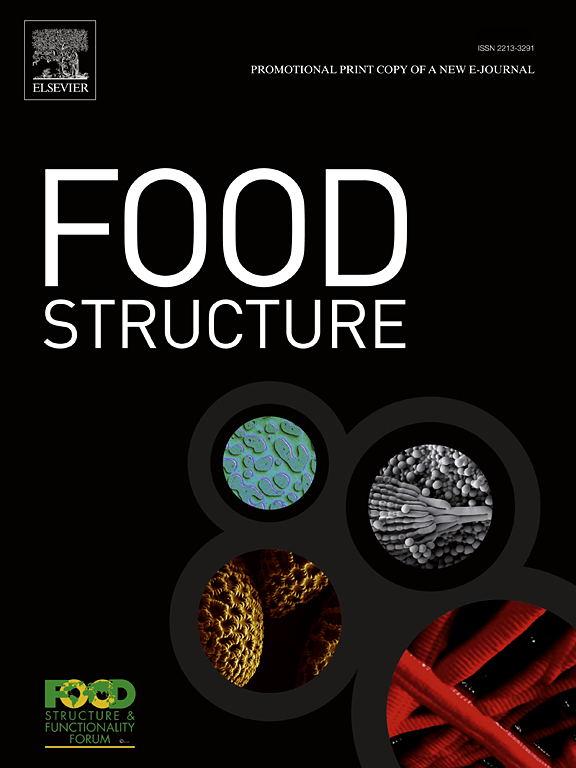Regulation of viscosity and structural properties of corn starch via one-step citric acid-reactive extrusion
IF 5.9
3区 农林科学
Q1 FOOD SCIENCE & TECHNOLOGY
引用次数: 0
Abstract
To decrease the viscosity of corn starch (CS) using extrusion technology, the effects of citric acid (CA) on viscosity and structural characteristics of corn starch based on one-step reactive extrusion were studied. The addition of CA partially destroyed the morphology of CS and induced starch to aggregate with each other, thus increasing the average particle size of CS from 14.42 μm to 129.63 μm. X-ray diffraction showed that the crystalline structure of CS was disrupted, and the relative crystallinity decreased from 13.47 % to 2.42 % with the increasing CA amount. Fourier transform infrared spectroscopy confirmed that there was covalent bond (C![]() O) between CS and CA, and the short-range ordered degree of CS was relied on CA content. Compared to unmodified CS, the citric acid-reactive extrusion declined the peak viscosity and setback of CS by 76.7 % and 87.1 %. The higher level of CA increased the degree of substitution and free water content of CS while reduced the storage modulus and loss modulus of CS. Correlation analysis demonstrated that the peak viscosity of CS was associated to the relative crystallinity, short-range ordered degree, mean particle size and free water content of CS. Overall, these findings provided a data support to produce low viscosity of corn starch.
O) between CS and CA, and the short-range ordered degree of CS was relied on CA content. Compared to unmodified CS, the citric acid-reactive extrusion declined the peak viscosity and setback of CS by 76.7 % and 87.1 %. The higher level of CA increased the degree of substitution and free water content of CS while reduced the storage modulus and loss modulus of CS. Correlation analysis demonstrated that the peak viscosity of CS was associated to the relative crystallinity, short-range ordered degree, mean particle size and free water content of CS. Overall, these findings provided a data support to produce low viscosity of corn starch.
一步柠檬酸反应挤出法对玉米淀粉粘度和结构特性的调控
为降低玉米淀粉(CS)的粘度,采用一步反应挤压法研究了柠檬酸(CA)对玉米淀粉粘度和结构特性的影响。CA的加入部分破坏了CS的形态,诱导淀粉相互聚集,使CS的平均粒径从14.42 μm增加到129.63 μm。x射线衍射结果表明,随着CA用量的增加,CS的晶体结构被破坏,相对结晶度从13.47 %下降到2.42 %。傅里叶变换红外光谱证实CS与CA之间存在共价键(CO), CS的短程有序度依赖于CA的含量。与未改性CS相比,柠檬酸反应挤出使CS的峰值粘度和后退度分别降低了76.7 %和87.1 %。较高的CA含量增加了CS的取代度和自由水含量,降低了CS的储存模量和损失模量。相关分析表明,CS的峰值粘度与CS的相对结晶度、近程有序度、平均粒径和自由含水量相关。总之,这些发现为生产低粘度玉米淀粉提供了数据支持。
本文章由计算机程序翻译,如有差异,请以英文原文为准。
求助全文
约1分钟内获得全文
求助全文
来源期刊

Food Structure-Netherlands
Chemical Engineering-Bioengineering
CiteScore
7.20
自引率
0.00%
发文量
48
期刊介绍:
Food Structure is the premier international forum devoted to the publication of high-quality original research on food structure. The focus of this journal is on food structure in the context of its relationship with molecular composition, processing and macroscopic properties (e.g., shelf stability, sensory properties, etc.). Manuscripts that only report qualitative findings and micrographs and that lack sound hypothesis-driven, quantitative structure-function research are not accepted. Significance of the research findings for the food science community and/or industry must also be highlighted.
 求助内容:
求助内容: 应助结果提醒方式:
应助结果提醒方式:


